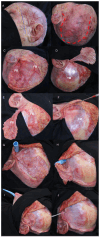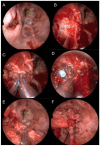Temporoparietal Fascia Flap (TPFF) in Extended Endoscopic Transnasal Skull Base Surgery: Clinical Experience and Systematic Literature Review
- PMID: 39685676
- PMCID: PMC11641987
- DOI: 10.3390/jcm13237217
Temporoparietal Fascia Flap (TPFF) in Extended Endoscopic Transnasal Skull Base Surgery: Clinical Experience and Systematic Literature Review
Abstract
Background and Objectives: The temporoparietal fascia flap (TPFF) has recently emerged as an option for skull base reconstruction in endoscopic transnasal surgery when vascularized nasal flaps are not available. This study provides a systematic literature review of its use in skull base surgery and describes a novel cohort of patients. Methods: PRISMA guidelines were used for the review. Patients undergoing skull base reconstruction with TPFF in our center from May 2022 to April 2024 were retrospectively included. Data were collected on pre- and post-operative clinical and radiological features, histology, surgical procedures, and complications. Results: Sixteen articles were selected, comprising 42 patients who underwent TPFF reconstruction for treatment of complex skull base pathologies. In total, 5 of 358 patients (0.9%) who underwent tumor resection via endoscopic transanal surgery in the study period in our institution required TPFF. All had been previously treated with surgery and radiation therapy for different pathologies (three chordomas, one giant pituitary neuroendocrine tumor (PitNET), and one sarcoma). Post-operative complications included CSF leak, which resolved after flap revision, and an internal carotid artery pseudoaneurysm requiring endovascular embolization. Conclusions: TPFF is an effective option for skull base reconstruction in complex cases and should be part of the armamentarium of the skull base surgeon.
Keywords: cranial base reconstruction; endoscopic transnasal surgery; neurosurgery; skull base reconstruction; temporo-parietal flap; vascularized flap.
Conflict of interest statement
The authors declare no conflicts of interest.
Figures





References
Publication types
LinkOut - more resources
Full Text Sources
Miscellaneous

